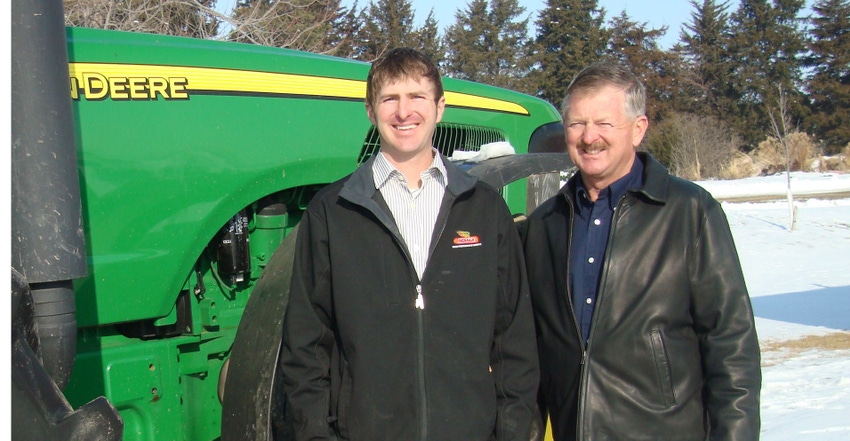May 2, 2018

Northeast Kansas grower Ken McCauley did most of his expansion in the 1980s and ’90s. At 67, he’s content with those acres. But his son, Brad, is slowly expanding through more rented ground in hopes of more profits.
The McCauleys, like many farmers, see getting bigger as a risk that must be measured closely.
While growers nationwide have tightened their belts after years of low grain prices and high input costs, some have kept their bottom line stable and believe they’re ready to grow. Here’s a closer look at the key factors you need to consider if you’re pulling the trigger on expansion in the next few years.
1. Do a Reality Check
Ag economists warn that with expansion, farmers may face financial and management realities that could hamper buying or renting more land. And diversifying to a new commodity may not be as easy as imagined.
In January, the Purdue/CME Group Ag Economy Barometer said despite less optimism about future economic conditions, producers seem more willing to make large investments in farm machinery and buildings than a year earlier. The same goes for overall expansion.
Mike Boehlje, Purdue University ag economics professor emeritus, says farmers who may want to expand are careful about who they share that desire with. “Given the current perspective in farm country, not too many farmers thinking about it are talking about it at the coffee shop,” he says. “They don’t want to offend others in a bad situation. Also, if they want to negotiate prices, they are careful at how willing they are to talk about expansion.”
The current stickiness in cash rents is one clue that expansion-minded farmers are willing to spend a little more in certain cases. “We haven’t seen much decline in cash rents as economic situations might indicate,” Boehlje says. “Farmland prices haven’t softened much, and people are showing up at land auctions and machinery auctions and bidding.”
“Don’t try to grow your business faster than your financial capacity can absorb,” advises ag economist Mike Boehlje.
Before trying to grow, Boehlje advises growers to fine-tune their current crop or livestock program. “Some try to expand before they’re ready. But they should get better before they get bigger,” he explains. “Make sure your core area of production is as efficient as possible. The kinds of prices we’re seeing on equipment and farmland mean farmers are making multimillion-dollar decisions. Make sure you ready to make those decisions.”
2. Use Working Capital Wisely
Sufficient working capital is likely the biggest concern in farm expansion. McCauley farms about 2,300 acres near White Cloud, Kan. His son farms a similar amount of ground but may add more. McCauley says access to stable working capital is a reason for younger growers to expand. “I think there are still a lot of reasons to expand,” he says. “Last year we saw good yields and beans showed some profits. But with expansion, you have to work harder and make your machinery go further.
“Brad may pick up any piece of rented land he thinks would work, but he wants it nearby. If there’s any land for sale, it has to be close and at a halfway reasonable price. There are no bargains anywhere. And working capital is essential to make it work.”
McCauley says even though farmland is always on the market, its profit potential is likely slim. “You can’t make land pencil out unless you have cash,” he says. “Even then, it doesn’t make much sense to spend $8,000 to $10,000 per acre on land [in Kansas] unless you have a lot of cash to put down on it.”
Boehlje says some farmers blow through too much working capital when expanding.
“Don’t get into an expansion mode too fast. Be careful not to destroy the financial reserve you have,” he says. “Some have been too aggressive in buying machinery for depreciation tax deductions. Rather than finance it, they use a lot of cash and destroy their working capital. That could cause difficulty in obtaining operating funds.
“Also, if you’re heavily leveraged, worry about managing your financial resiliency rather than growing your business. Don’t try to grow your business faster than your financial capacity can absorb.”
Along with land expansion, diversification is tempting. But before pulling the trigger on a new crop or livestock enterprise, make sure you understand the management practices needed, as well as the risks involved.
“For example, with current grain prices, going from corn or soybeans to wheat doesn’t give you as much risk reduction as you think,” Boehlje says, adding that diversifying to a different commodity can be as risky, since it may be shaped by the same supply-and-demand forces.
“Some feel they should expand to organic production. But in dairy, for example, we see a surplus of organic milk. Such situations must be considered before expanding to a new enterprise.”
3. Know Your Technology
New technology lets you do a better job at what you’re doing. But before upgrading to new software or equipment, analyze whether the tech will increase productivity. If you have the evidence, then new technology is a way to improve your current efficiency and help in expansion.
McCauley says he and his son depend on farm management software, “but try not to get too detailed. We use the Climate FieldView system from Monsanto. Everything we do, from soil grid tests to anhydrous applications, planting, spraying and harvesting, is easily monitored on an iPad. It’s the first time I’ve had everything at my fingertips.”
The ability to grow revenue without spending much more money can be enhanced through technology, Boehlje says. “You intensify. You get more out of your inputs,” he says. “You use better seed genetics, improve your nutrient management or other production techniques. Grow your top line to grow your bottom line.”
4. Manage Risk
Expansion likely requires a good rapport with lenders, who are usually cautious and conservative. Lenders can be particularly nervous about farmers who’ve been aggressive in growing with rental strategies.
“Rent bids haven’t declined much, and they’re losing money,” Boehlje says. “They’re not getting their landlords to adjust down rental rates. It depends on each situation, but those customers have the most serious financial challenges.”
Unless you’re considered a financial risk, ag bankers probably won’t require growers to lay out a hedging strategy before approving a loan, but it’s standard for their farmer-customers to have crop insurance. Lenders try to do what they legally can to encourage customers to manage operating risk. If you have Revenue Protection insurance, you get some protection on price and yield.
With expansion, expect problems at the start and benefits to come slowly. “Most farmers don’t spend enough time thinking about that,” Boehlje says. “The barn or shed construction doesn’t get finished when you thought it would, or it takes longer to understand the efficiencies of the land you rented. You have to position yourself to have the financial reserves needed to make it through startup problems.”
At first, a new enterprise often generates more costs than revenues, he says. “Most expansion doesn’t perform as you planned until after 18 and often up to 24 months.”
Boehlje says without strong working capital or debt service repayment capacity, “you should probably be in a stand-down mode. The most vulnerable position in a high-risk environment is to try to grow your business faster than your financial capacity can absorb.”
Expansion or not, prices don’t look promising to McCauley. “I feel we need to learn how to make money on $3.50 corn,” he says. “If it goes up to $4, it won’t stay there long. You need to have on your thinking cap when there’s an option to expand. Land and crop prices, machinery, and other inputs all matter. If you farm in an area where a lot of land is up for sale or rent, you have to be ready.”
Stalcup writes from Amarillo, Texas
About the Author(s)
You May Also Like




